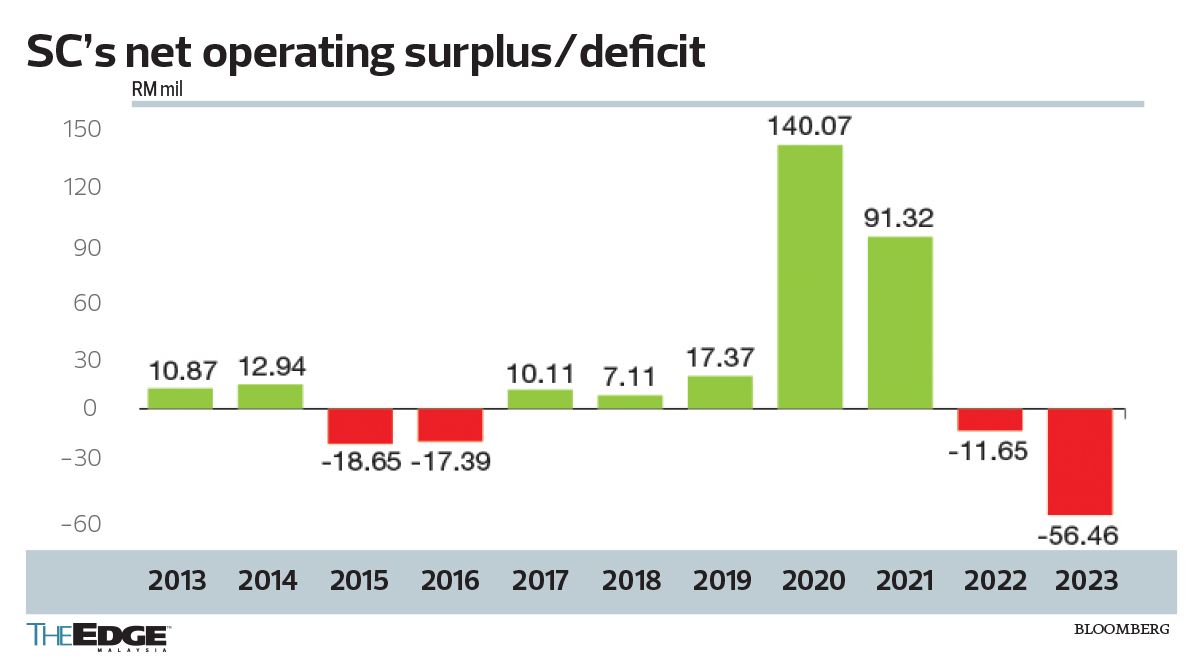
This article first appeared in The Edge Malaysia Weekly on February 24, 2025 - March 2, 2025
IN 2023, Securities Commission Malaysia (SC) posted its largest net operating deficit of RM54.64 million in at least a decade.
SC’s revenue in 2023, which was derived from levies, fees and charges, licence fees and registration fees, amounted to RM167.28 million. Meanwhile, the regulator’s other income of RM5.89 million was from penalty income, recovery of investigation and proceedings costs, residual sums and net fair value gain or loss on financial assets at fair value through profit or loss.
Together with an income of RM36.74 million from fixed deposits, bonds and unit trusts, SC’s total income in 2023 was RM209.91 million.
The regulator’s total expenditure increased to RM266.36 million from RM237.8 million in 2022. Staff costs are the biggest component at RM209.66 million, up 9.6% from RM191.22 million in 2022.
Notably, SC’s staff costs climbed almost 35% in three years from RM155.74 million in 2019. SC’s staff salaries were reviewed in 2022, under executive chairman Datuk Mohammad Faiz Azmi’s predecessor Datuk Seri Awang Adek Hussin. Staff costs — which include remuneration, bonus, medical, training and overtime, defined contribution plan, other employee benefits and post-employment benefits — were RM209.66 million.
Even so, the regulator is unable to match the salaries paid by financial institutions and other employers in a similar category.
Owing to the high costs involved, Mohammad Faiz says the attrition rate at SC was high, about 12% in 2024, and 9% to 10% over the last nine years.
Against this backdrop, SC has been in talks with market participants, including those dealing in bonds, brokerage income (including platform fee), underwriting fee, placement fee, commission including success fee, completion fee, advisory fee and commission fee from the distribution of unit trust products — about the imposition of a levy, which could be as high as 1.5% of their revenue.
According to Mohammad Faiz, the fee structure has remained unchanged since the regulator was established in 1993, with some fees leaving SC at a disadvantage. Given the many plans he has for the regulator, he asserts that a higher fee is now necessary.
“Something like 80% of my [SC’s] revenue is variable, but all my costs are fixed … So, clearly, there’s a problem. [The levy from revenue] varies. So, it’s not a set percentage for everything. Of course, in the negotiation, we start with a number, then we find [an agreed figure] somewhere in between. But it goes back to fairness. If your revenues are in the billions, I’m talking about a [levy of a] few million.
“And we’ve done the stress test. For most of the entities, it’s less than 1% of their revenue. Profit is a different story, because some are profitable, some are not. And then we discover there’s also a game going on. For example, in a banking group, I might only regulate the stockbrokers, but there’s also all kinds of transfer pricing going on. So, the number of stockbrokers may not be reflective of what they’re really doing,” Mohamad Faiz explains.
SC has been engaging the requisite associations and bodies, including the Association of Stockbroking Companies Malaysia (ASCM), the Malaysian Investment Banking Association and the Federation of Investment Managers Malaysia.
Talks with ASCM, which represents 29 stockbrokers nationwide, are understood to be progressing well.
In a response to questions from The Edge a couple of weeks ago, ASCM said, “We are currently conducting a thorough review.
“As an industry association representing Malaysia’s stockbroking community, we fully support SC’s vital role in maintaining a robust and dynamic capital market. We recognise the need for adequate funding for SC’s crucial oversight and regulatory functions.”
SC’s office in Bukit Kiara — which houses the commission and its training arm, the Securities Industry Development Centre, which was constructed in February 1999 — was meant to house 500 employees. Today, SC has about 800 employees. These issues have led to the need for the regulator to generate more income.
He explains, “As an illustration, 2023 was a bad year; we made a RM100 million loss. The following year was a good one, but I still made a loss of RM2 million. So, clearly, there’s a problem. The other thing about the fees is that 80% of it is from the equity levy — RM144 million in 2023 and RM200 million in 2024. But that’s to cover a cost base of about RM300 million.
“But that equity levy doesn’t cover only equity enforcement. It covers bond enforcement, auditors, Islamic and structured products. And I also have to worry about scammers.
“It should be that people who gain or benefit should contribute [to the cost of maintaining a fair and orderly market].”
Save by subscribing to us for your print and/or digital copy.
P/S: The Edge is also available on Apple's App Store and Android's Google Play.
- Global funds hit pause on Indonesia after Prabowo policy changes
- Trump warns tariffs coming for electronics after reprieve
- China calls for greater cooperation with Vietnam
- Miti to present new analysis on impact of US tariffs at National Geo-Economic Action Council meeting on Monday
- Stocks bounce in Asia as some US tariffs paused
- Indonesia’s foreign reserves hit record high despite rupiah rout
- Frankly Speaking: JAC review should take precedence
- China's March exports jump on pre-tariff rush, but trade war dims outlook
- Copper edges higher as tariff reprieve gives traders some relief
- MIDF: Foreign investors pull US$5.87b from Asian markets

